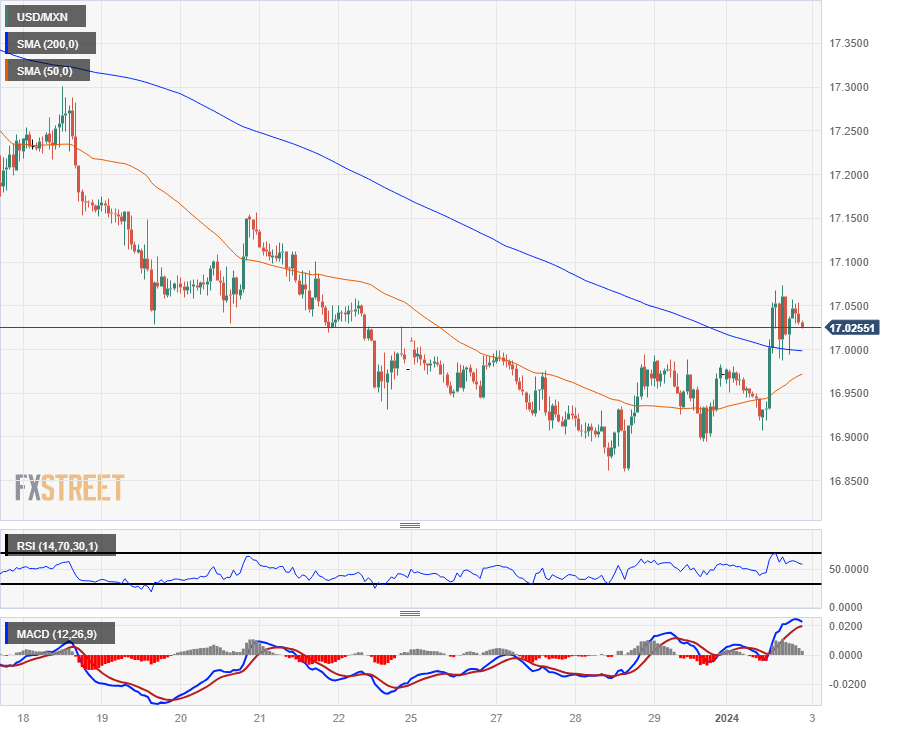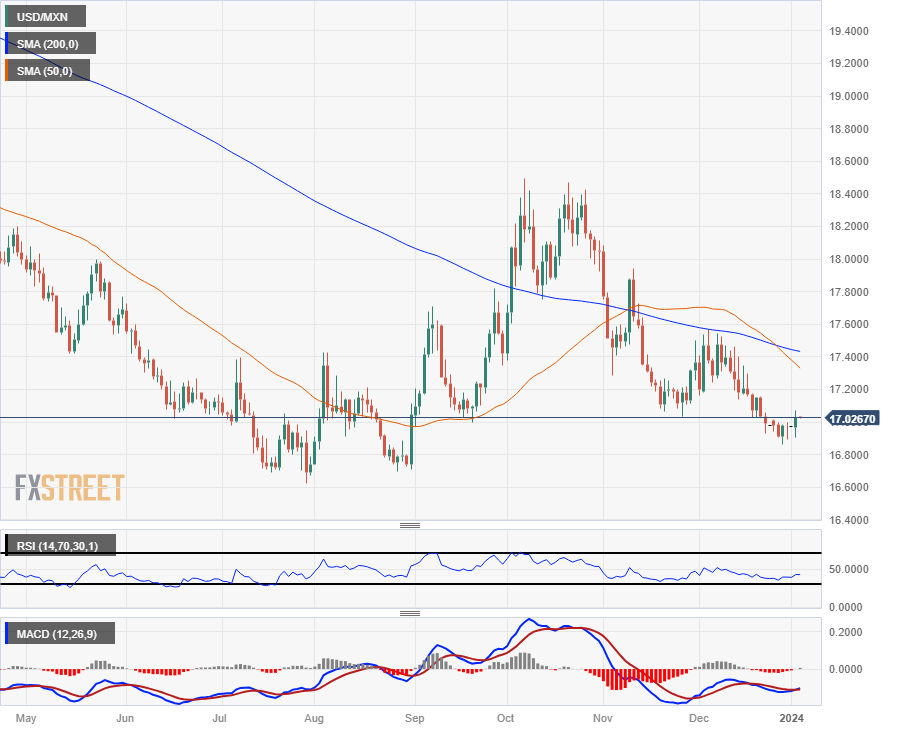Most recent article: Mexican Peso struggles as US Dollar gains momentum
- The Mexican Peso has slipped as broader markets focus on US data.
- Notable lack of Mexico data on the docket for this week.
- Markets are set to hinge on US labor, output figures ahead of NFP Friday.
The Mexican Peso (MXN) is taking a breather, retreating from a 17-week high against the US Dollar (USD) as markets kick off the new trading year focusing on US labor and output data.
Economic data from Mexico is absent from the calendar for this week, and the USD is set to be the primary driver to usher in 2024. The Greenback is rebounding in early trading as money markets ease back on bets of Federal Reserve (Fed) rate cuts, with the US Dollar reclaiming around a full percent against the Peso.
Daily digest market movers: Mexican Peso gives back recent gains as investors look to US NFP
- The US Dollar is climbing across the board to kick off the new year’s inaugural trading week.
- Money markets have eased back their bets of Fed rate cuts, still see up to 150 basis points in rate cuts through 2024.
- US output continues to fall, S&P Global Manufacturing Purchasing Managers’ Index (PMI) for December declined to 47.9, a four-month low. Median market forecast expected a steady print at November’s 48.2.
- US Construction Spending also missed the mark, slipping from October’s 1.2% (revised up from 0.6%) to print at 0.4% in November, missing the forecast of 0.5%.
- Wednesday brings the US ISM Manufacturing PMI, as well as the latest round of the Fed’s Meeting Minutes.
- Thursday sees the December print of the ADP Employment Change, but the figure has become notoriously inconsistent lately, poorly forecasting the release of Friday’s US Nonfarm Payrolls, alongside US Average Earnings and the ISM Services PMI.
US Dollar price this week
The table below shows the percentage change of US Dollar (USD) against listed major currencies this week. US Dollar was the strongest against the Swiss Franc.
| USD | EUR | GBP | CAD | AUD | JPY | NZD | CHF | |
| USD | 1.01% | 0.88% | 0.61% | 0.80% | 0.66% | 1.08% | 1.09% | |
| EUR | -0.86% | 0.04% | -0.27% | -0.06% | -0.34% | 0.22% | 0.18% | |
| GBP | -0.90% | -0.04% | -0.28% | -0.10% | -0.14% | 0.18% | 0.14% | |
| CAD | -0.61% | 0.23% | 0.46% | 0.17% | 0.04% | 0.46% | 0.44% | |
| AUD | -0.81% | 0.05% | 0.09% | -0.21% | -0.33% | 0.28% | 0.25% | |
| JPY | -0.65% | 0.36% | 0.29% | 0.15% | 0.33% | 0.59% | 0.36% | |
| NZD | -1.09% | -0.23% | -0.19% | -0.48% | -0.28% | -0.61% | -0.05% | |
| CHF | -1.04% | -0.18% | -0.14% | -0.43% | -0.22% | -0.40% | 0.07% |
The heat map shows percentage changes of major currencies against each other. The base currency is picked from the left column, while the quote currency is picked from the top row. For example, if you pick the Euro from the left column and move along the horizontal line to the Japanese Yen, the percentage change displayed in the box will represent EUR (base)/JPY (quote).
Technical Analysis: Mexican Peso fades top side, eases back as US Dollar rebounds
The Mexican Peso (MXN) is slipping back from near-term highs, getting pushed back down as market pivot into Greenback bets. The USD/MXN has rebounded above the 200-hour Simple Moving Average (SMA), climbing back over the 17.00 level following last week’s decline to a multi-month low of 16.86.
Bullish momentum in the US Dollar still faces a long climb upwards, with long-term technical resistance sitting at the bearish crossover of the 50-day and 200-day SMAs just south of 17.50. On the low side, a break below 2023’s lows of 16.62 will see the USD/MXN breaking into its lowest bids since 2016.
USD/MXN Hourly Chart

USD/MXN Daily Chart

Mexican Peso FAQs
What key factors drive the Mexican Peso?
The Mexican Peso (MXN) is the most traded currency among its Latin American peers. Its value is broadly determined by the performance of the Mexican economy, the country’s central bank’s policy, the amount of foreign investment in the country and even the levels of remittances sent by Mexicans who live abroad, particularly in the United States. Geopolitical trends can also move MXN: for example, the process of nearshoring – or the decision by some firms to relocate manufacturing capacity and supply chains closer to their home countries – is also seen as a catalyst for the Mexican currency as the country is considered a key manufacturing hub in the American continent. Another catalyst for MXN is Oil prices as Mexico is a key exporter of the commodity.
How do decisions of the Banxico impact the Mexican Peso?
The main objective of Mexico’s central bank, also known as Banxico, is to maintain inflation at low and stable levels (at or close to its target of 3%, the midpoint in a tolerance band of between 2% and 4%). To this end, the bank sets an appropriate level of interest rates. When inflation is too high, Banxico will attempt to tame it by raising interest rates, making it more expensive for households and businesses to borrow money, thus cooling demand and the overall economy. Higher interest rates are generally positive for the Mexican Peso (MXN) as they lead to higher yields, making the country a more attractive place for investors. On the contrary, lower interest rates tend to weaken MXN.
How does economic data influence the value of the Mexican Peso?
Macroeconomic data releases are key to assess the state of the economy and can have an impact on the Mexican Peso (MXN) valuation. A strong Mexican economy, based on high economic growth, low unemployment and high confidence is good for MXN. Not only does it attract more foreign investment but it may encourage the Bank of Mexico (Banxico) to increase interest rates, particularly if this strength comes together with elevated inflation. However, if economic data is weak, MXN is likely to depreciate.
How does broader risk sentiment impact the Mexican Peso?
As an emerging-market currency, the Mexican Peso (MXN) tends to strive during risk-on periods, or when investors perceive that broader market risks are low and thus are eager to engage with investments that carry a higher risk. Conversely, MXN tends to weaken at times of market turbulence or economic uncertainty as investors tend to sell higher-risk assets and flee to the more-stable safe havens.
Information on these pages contains forward-looking statements that involve risks and uncertainties. Markets and instruments profiled on this page are for informational purposes only and should not in any way come across as a recommendation to buy or sell in these assets. You should do your own thorough research before making any investment decisions. FXStreet does not in any way guarantee that this information is free from mistakes, errors, or material misstatements. It also does not guarantee that this information is of a timely nature. Investing in Open Markets involves a great deal of risk, including the loss of all or a portion of your investment, as well as emotional distress. All risks, losses and costs associated with investing, including total loss of principal, are your responsibility. The views and opinions expressed in this article are those of the authors and do not necessarily reflect the official policy or position of FXStreet nor its advertisers. The author will not be held responsible for information that is found at the end of links posted on this page.
If not otherwise explicitly mentioned in the body of the article, at the time of writing, the author has no position in any stock mentioned in this article and no business relationship with any company mentioned. The author has not received compensation for writing this article, other than from FXStreet.
FXStreet and the author do not provide personalized recommendations. The author makes no representations as to the accuracy, completeness, or suitability of this information. FXStreet and the author will not be liable for any errors, omissions or any losses, injuries or damages arising from this information and its display or use. Errors and omissions excepted.
The author and FXStreet are not registered investment advisors and nothing in this article is intended to be investment advice.
Recommended content
Editors’ Picks

EUR/USD holds above 1.0400 in quiet trading
EUR/USD trades marginally higher above 1.0400 in the second half of the day on Friday. The absence of fundamental drivers and thin trading conditions on the holiday-shortened week make it difficult for the pair to gather directional momentum.

GBP/USD recovers to 1.2550 area following earlier decline
GBP/USD regains its traction and trades in positive territory near 1.2550 after declining toward 1.2500 earlier in the day. Nevertheless, the cautious market mood limits the pair's upside as trading volumes remain low following the Christmas break.

Gold struggles to build on weekly gains, holds above $2,620
Gold enters a consolidation phase and trades below $2,630 on Friday after posting modest gains on Thursday. The risk-averse market atmosphere helps XAU/USD limit its losses as investors refrain from taking large positions heading into the end of the holiday-shortened week.

Bitcoin misses Santa rally even as on-chain metrics show signs of price recovery
Bitcoin (BTC) price hovers around $97,000 on Friday, erasing most of the gains from earlier this week, as the largest cryptocurrency missed the so-called Santa Claus rally, the increase in prices prior to and immediately following Christmas Day.

2025 outlook: What is next for developed economies and currencies?
As the door closes in 2024, and while the year feels like it has passed in the blink of an eye, a lot has happened. If I had to summarise it all in four words, it would be: ‘a year of surprises’.

Best Forex Brokers with Low Spreads
VERIFIED Low spreads are crucial for reducing trading costs. Explore top Forex brokers offering competitive spreads and high leverage. Compare options for EUR/USD, GBP/USD, USD/JPY, and Gold.